|
Samantha Anne Hilber |
![[Go to CSUS Home Page]](gifs/csus_logo.jpg) |
|
Samantha Anne Hilber |
![[Go to CSUS Home Page]](gifs/csus_logo.jpg) |
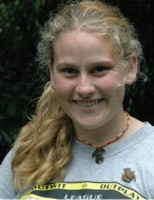
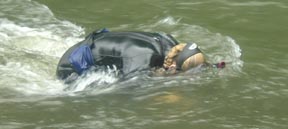
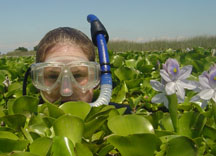
I am currently a PhD student at the University of Florida, in Dr. Colette St. Mary's Lab. I am conducting research in the field of evolutionary ecology, with a focus on the reproductive behavior of fishes, e.g., mate selection, conflict between the sexes, and parental care of offspring. I am interested in the evolutionary process that lead to the fascinating behavior of animals.
Education
Ph.D. Zoology
University of Florida
Fall 2006 - present
B.S. Biological Sciences
California State University Sacramento
Fall 2001 - Spring 2006
Publications
Hilber, S.A., and R.M. Coleman. 2006. Egg size through consecutive spawnings in the convict cichlid. Copeia (submitted).
Non-Refereed Publications (e.g., magazine articles)
Hilber, S.A. and R.M. Coleman. July 2006. Cichlid research and adventures in Costa Rica. Tropical Fish Hobbyist 54 (11): 108-112.
Hilber, S.A. and R.M. Coleman. July 2007. Mating systems and parental care in cichlids. Tropical fish Hobbyist 55 (11): 104-108.
Independent Undergraduate Research (June 2005 - February 2006)
Egg size through consecutive spawning in mouthbrooding cichlids
Continuing my undergraduate thesis work and I examined changes in mean egg size and variance of egg size over the first five consecutive spawnings of cichlids. This research focused on mouthbrooding species (Astatotilapia nubilus and Pseudocrenilabrus multicolor). I hope to determine if the same pattern I found in convict cichlids (larger size of egg in first spawnings; see below) exists for these mouthbrooding African cichlid species.
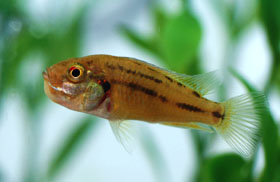
Psudocrenilabrus multicolor (left) female and Astatotilapia nubilus (right) female holding (they have eggs in their mouth). The eggs will hatch and develop into fry (baby free-swimming fish) before the female will let them out of her mouth. During this time (about 2-3 weeks) the females will not eat. The P. multicolor (left) female was about 3.5 cm and it was her second spawning. The A. nubilus (right) female was about 6.6 cm and it was her third second.
Undergraduate Honors Thesis (June 2004 - July 2005)
Egg size through consecutive spawnings in the convict cichlid
Life history theory examines how organisms resolve tradeoffs in resource allocation. After a female has determined how much to invest in reproduction, she must then determine how to divide up this finite amount of resources into individual packages (offspring). Theory predicts that a female should decide what size of offspring to make then vary the number of offspring according to the amount of resources available. Previous work has shown that different species resolve this tradeoff differently. Do females within the same species resolve this tradeoff the same way; and furthermore, does an individual female resolve this tradeoff the same way at every breeding event in her life?
To investigate this, I examined the clutches of convict cichlids (Archocentrus nigrofasciatus) over five consecutive breeding events to determine if there are changes in mean egg size and changes in variance of egg size. My results revealed that female convict cichlids lay a larger egg the first time they spawn than in subsequent spawnings. The variance of egg size was not affected by spawning sequence. It is not clear what selection pressure is causing mean egg size to decrease. Further investigation is needed to understand the selection pressures that are affecting females during their first breeding events that have subsequently favored interesting life history characteristic.
This work has been submitted to Copeia for publication.
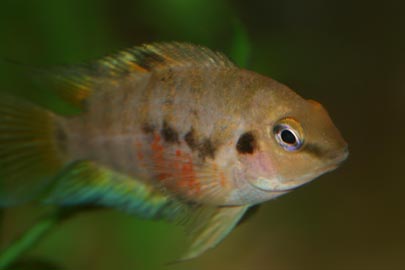
A young eager female before her first spawn & a pair spawning (the eggs on the ceiling of the pot).
Research Assistant in Costa Rica
Investigating parental care of cichlid fishes in the wild (January 2005 & January 2006).
Principle Investigator: Dr. Ronald M. Coleman, Biological Sciences, CSUSCichlidae is a large family of fishes, all of which exhibit some form of parental care, which in general is not common in fishes. In the rivers of Costa Rica, there are several species of cichlids that actively care for their offspring. By observing cichlids in the wild, I learned about the complex interactions a fish has with its environment. There are many environmental pressures a parent has to take into account when deciding when and where to spawn including water velocity, substrate composition, temperature, mate availability and predator density. Predicting storm events for a parent is a particularly interesting question because small fry are washed away in big storms.
The fish above is an Archocentrus sajica female with her offspring (from south west Costa Rica).
I also saw some exciting herps while hiking the trails in the rainforest at Le selva research station; including, and Strawberry Dart Frog & Smokey Jungle Frog (top), Slender Anole (middle), and Fer-de-lance & Brown Vine snake (bottom). I was bitten by this very pretty Brown Vine snake who did not like being picked up.
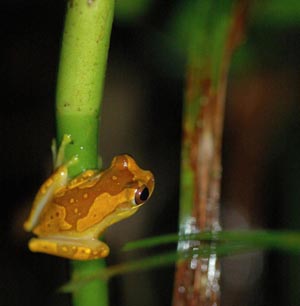
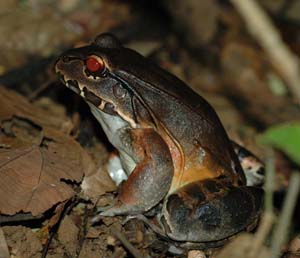
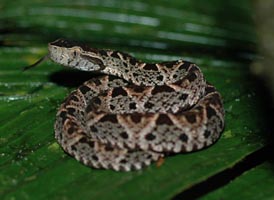
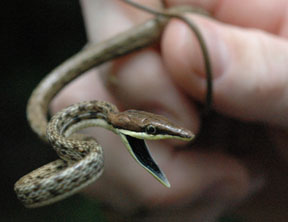
Survey Assistant
Delta Smelt Habitat Assessment and Survey, California Department of Transportation Fish Survey, Stockton, CA (May – June 2005)
Project Leader: Ronald M. Coleman, Assistant Professor, Biological Sciences, CSUS
Principle Investigator: Michael F. Baad, Professor, Biological Sciences, CSUSConstruction was scheduled for highway 4 in Stockton, CA, on and CalTrans needed to know if any endangered fish was present in nearby water habitat. I assisted with the ichthyological survey of this area looking for delta smelt, the only endangered fish likely to be prevalent in this water system. We conducted the survey by snorkeling the slough at several locations and multiple times. We did not see a delta smelt, but we did see many other interesting fishes. There were several bluegill sunfish colonies, and largemouth bass males actively guarding nests. With so many non-native predators, and this particular water habitat not being connected with the rest of the water shed, it was not surprising to not see delta smelt.
I was even bitten by a largemouth bass for being to close to his kids. To see video of this dad go to Ron Coleman's Research Page.
Scholarships, Awards & Honors
Clair A. Hill Scholarship, Carmichael Water District, The Association of California Water Agency (November 14, 2005)
$3000 (awarded for scholastic achievement, and commitment and motivation to a career in the field of water resources)Faculty Senate Merit Scholarship Award, CSU Sacramento (February 17, 2005)
$1412 (awarded to three undergraduates each year, for high academic achievement and service to the university and community)Governor’s Scholarship, Sacramento High School, California (May 2000)
$1000 (awarded for high score on STAR standardized test)Dean’s Honors List, CSU Sacramento (Fall 2001 - Spring 2006)
Semester GPA over 3.25 for 10 semesters out of 10 semesters enrolled
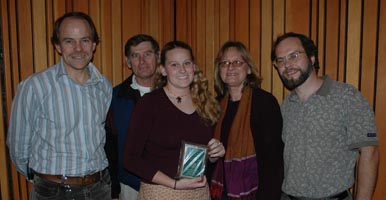
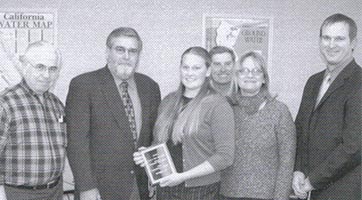
On the left, here I am receiving my Faculty Senate Merit Award (with my parents and two of my faculty supporters). On the right, here I am receiving my ACWA Clair A. Hill Award (with my parents, the District President, ACWA Region 4 Chair, and the CH2M Hill representative).
Small Travel Grants
Student Academic Development Program, Student Travel Fund, CSU Sacramento (November 2005)
$250 (awarded for traveling to present at the Annual American Society of Ichthyologists and Herpetologists Conference in Tampa, FL)Academically Related Activities Program, Student Travel Fund, CSU Sacramento (October 2005)
$400 (awarded for traveling to present at the Annual American Society of Ichthyologists and Herpetologists Conference in Tampa, FL)Individual SEL Grant from Associated Students Inc. CSU Sacramento (March 2005)
$150 (awarded for traveling to present at the Annual American Society of Ichthyologist and Herpetologist Conference in Tampa, FL)Individual SEL Grant from Associated Students Inc. CSU Sacramento (October 2004)
$150 (awarded for traveling to Costa Rica as a research assistant in January 2005)
Oral Presentations
Ecology and Evolutionary Ethology of Fishes Biannual Conference, Student Competition, Aliso Viejo, CA (June 5, 2006)
“Egg size through successive spawnings in the convict cichlid"American Society of Ichthyologists and Herpetologists Conference, Student Competition, Tampa, FL (July 6, 2005)
“Egg size through successive spawnings in the convict cichlid"CSU Student Research Competition, at CSU Sacramento, CA (April 29, 2005)
“Egg size through successive spawnings in the convict cichlid”CSUS Student Research Competition, Sacramento, CA (March 15, 2005)
“Egg size through successive spawnings in the convict cichlid”
Poster Presentations
Sigma Xi Annual Meeting & Student Research Conference, Seattle, WA (November 4 & 5, 2005)
“Egg size through consecutive spawnings in the convict cichlid”
Museum of Ectothermic Vertebrates Curatorial Assistant (August 2004 – May 2006)
Supervisors: Melissa Schlenker and Ronald M. Coleman, Biological Sciences, CSUS
I was responsible for maintaining the preserved fish, amphibian, and reptile specimens. This involved toping of alcohol jar, moving specimens to more appropriate jars, organizing specimens on the shelves, organizing museum records, and determining the current scientific name and family for many specimens.
A newly organized shelf in the Fish Museum
Animal Care Student Assistant (February 2004 – May 2006)
Supervisor: Jana E. Shober, Instructional Support Technician, Biological Sciences, CSUS
I was responsible with other students for maintaining the health of several reptiles and a few mammals. This involves feeding each animal the appropriate diet, cleaning cages, checking for illness, and walking some animals. I was also responsible for training new student assistants to care for these animals.
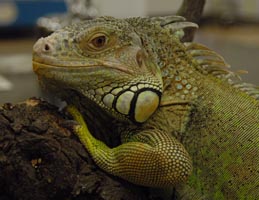
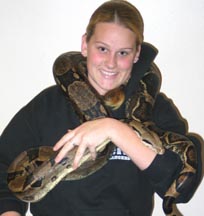
Petey the Iguana (my baby), Barney the Boa Constrictor (now living at the Sacramento Zoo with a girl!), and Vincent the Chinchilla (escape artist extraordinaire).
Volunteer Special Olympics Soccer Coach (August – November: 2002, 2003, 2004, 2005)
Head Coachs: Russell Wilson & Jennifer Wilson, TR Services, Sacramento County Recreation Department
I train a team of athletes with disabilities to compete in soccer tournaments. Most of these athletes are adults with various mental and/or physical disabilities. The program emphasized playing well with courage, and being a good sport.
New Student Orientation Leader (Summer 2002, 2003, 2004 (full-time) and Fall 2002, 2003 (part-time))
Supervisor: Mary Shepherd, Orientation Coordinator, Academic Advising, CSUSI served as a group leader for freshman and transfer students, and their parents. This included, presenting information to new students on academic requirements, student services, and campus life. A big part of my job was to assist new students in making course selections for their first semester at Sac State. I also, facilitated student and parent orientation programs, and conduct campus tours. After my first summer, I mentored two new orientation leaders each year.
I'm with my favorite Hornet, Herky.
|
|
![[Go to CSUS Home Page]](gifs/csus_logo.jpg)
|